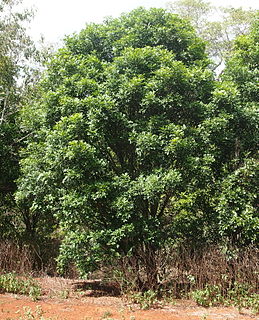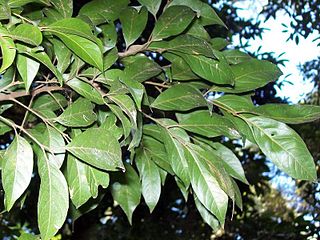
Alectryon is a genus of about 30 species of trees and shrubs from the family Sapindaceae. They grow naturally across Australasia, Papuasia, Melanesia, western Polynesia, east Malesia and Southeast Asia, including across mainland Australia, especially diverse in eastern Queensland and New South Wales, the Torres Strait Islands, New Guinea, the Solomon Islands, New Caledonia, New Zealand, Vanuatu, Fiji, Samoa, Hawaii, Indonesia and the Philippines. They grow in a wide variety of natural habitats, from rainforests, gallery forests and coastal forests to arid savannas and heaths.

Galbulimima is a genus of flowering plants and the sole genus of the family Himantandraceae. Members of the family are found in the tropical zones of eastern Malaysia, the Moluccas, the Celebes, New Guinea, northern Australia and the Solomon Islands.
Pilidiostigma is a genus of shrubs and small trees in the myrtle family Myrtaceae. All species occur in Australia and one, P. papuanum, also occurs in Papua New Guinea. They are not generally known to horticulture. The species P. sessile is rare.

Harpullia is a genus of about 27 species of small to medium-sized rainforest trees from the family Sapindaceae. They have a wide distribution ranging from India eastwards through Malesia, Papuasia and Australasia to the Pacific Islands. They grow naturally usually in or on the margins of rainforests or associated vegetation.

Jagera is a genus of 4 species of forest trees known to science, constituting part of the plant family Sapindaceae.

Diploglottis is a genus of 10 species of trees known to science, constituting part of the plant family Sapindaceae. They grow naturally in rainforests and margins of adjoining humid forests in eastern Australia and New Guinea. Some species are known as native tamarind or small-leaved tamarind; they have no direct relationship with the true tamarind.

Atalaya is a genus of eighteen species of trees and shrubs of the plant family Sapindaceae. As of 2013 fourteen species grow naturally in Australia and in neighbouring New Guinea only one endemic species is known to science. Three species are known growing naturally in southern Africa, including two species endemic to South Africa and one species in South Africa, Swaziland and Mozambique.
Dimocarpus australianus also known as Australian native lychee, is a species of trees, closely related to the longan, constituting part of the plant family Sapindaceae. They are endemic to Cape York Peninsula, Australia. The edible fruit tastes like lychee, sweeter than longan, and occasionally gets described as 'too sweet' in comparison by longan fanciers.

Cryptocarya triplinervis is a rainforest tree growing in eastern Australia. Common names include the three veined laurel, three veined cryptocarya and the brown laurel.

Sarcopteryx is a genus of about 12 rainforest tree species known to science, of the plant family Sapindaceae. They occur in Australia, New Guinea and the Moluccas.
Tristiropsis is a genus of about 14 flowering trees species, of the plant family Sapindaceae.

Harpullia arborea is a tree in the family Sapindaceae that grows up to 33 metres (108 ft) tall. It is found from India and Sri Lanka throughout Southeast Asia and Malesia to Australia and the Western Pacific.

Mischarytera is a genus of rainforest trees, constituting part of the plant family Sapindaceae. Four species are known to science as of December 2013, found growing naturally in eastern Queensland, Australia, and in New Guinea. Formerly until 1995, they had names within the genus Arytera, subgenus Mischarytera.

Sarcotoechia is a genus of tropical rainforest trees, constituting part of the plant family Sapindaceae.
Rhysotoechia is a genus of tropical rainforest trees, constituting part of the plant family Sapindaceae.
Synima is a genus of tropical rainforest trees, constituting part of the plant family Sapindaceae.

Deplanchea tetraphylla is a species of tropical rainforest trees, commonly known as golden bouquet tree, wallaby wireless tree or yellow pagoda flower tree, constituting part of the plant family Bignoniaceae.
Cnesmocarpon is a genus of 4 species of rainforest trees known to science, constituting part of the plant family Sapindaceae.
Dictyoneura is a genus of 2–3 species of rainforest trees known to science, constituting part of the plant family Sapindaceae.

Alectryon connatus, sometimes named hairy alectryon, is a species of small trees, constituting part of the plant family Sapindaceae.












